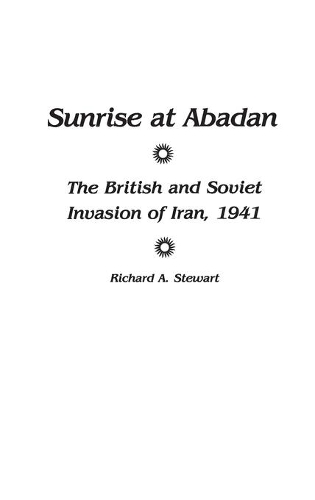
Sunrise at Abadan: The British and Soviet Invasion of Iran, 1941
(Hardback)
Publishing Details
Sunrise at Abadan: The British and Soviet Invasion of Iran, 1941
By (Author) Richard A. Stewart
Bloomsbury Publishing PLC
Praeger Publishers Inc
21st November 1988
United States
Classifications
Tertiary Education
Non Fiction
Second World War
Modern warfare
European history
940.5423
Physical Properties
Hardback
303
Width 152mm, Height 229mm
709g
Description
Sunrise at Abadan, portraying the dramatic events leading to the United States' deep involvement in Iran, sets the historic stage for the current crisis in the Persian Gulf region. It rapidly traces the ebb ad flow of Anglo-Russian rivalry over Persia from the reign of Peter the Great to World War II. By late summer of 1941, the Allies were reeling in defeat as Axis forces advaced triumphantly on all fronts. In a desperate move to avert Nazi victory, the British and Soviet governments suspended their political struggle for control of the Persian Gulf and jointly invaded neutral Iran. This controversial action toppled the powerful Shah, secured the vital Persian Gulf oil fields and opened the primary route for U.S. military aid to the beleaguered Soviet Union. Richard A. Stewart describes the rise to power of the late Shah Mohammed Reza Pahlavi and the events leading to the U.S. and Soviet confrontation over Iran in 1946. Carefully documented, his book raises important legal and moral questions about Allied actions while depicting the fate of a small but proud nation caught in a highstakes game of geopoliical intrigue, doublecross and shifting alliances. Sunrise at Abadan will stimulate the informed general reader while its original research will aid scholars of political science, Middle East studies, Soviet history and policy, and military studies.
Reviews
. . . It is a welcome addition to the historiography of World War II, telling an interesting, well-researched story. It is worth reading.-British Army Review
Using official documents in British, German, and US archives, as well as interviews with and the memoirs of more than three dozen participants and observes, Stewart has produced the most detailed and vivid account yet written of the events connected with the Anglo-Russian occupation of Iran in August and September, 1941. The Allies cited the presence of many German nationals in Iran as pretext for their invasion. Their more compelling motives, however, were to forestall a possible German entry entry through the Caucasus, to secure the main supply route for weapons destined for the USSR, and to safeguard Britain's oil interests in Khuzistan. Stewart probes Britain's moral dilemma caused by invading a neutral Iran, but concludes that Britain's desperate military position in 1941 justified the occupation. Competing Russian and Western interests in Iran, however, initiated the Cold War in that land long before VE day in Europe. This work supersedes such earlier military histories as Paiforce: The Official Story of the Persia and Iraq Command, 1941-1946 (London, 1948); and T.H. Vail Motter's The U.S. Army in World War II: The Persian Corridor and Aid to Russia (1956). The Iranian context can be further studied in George Lenczowski's Russia and the West in Iran, 1918-1948 (1949), and Iran Under the Pahlavis, ed. by George Lenczowski Bruce Kuniholm's The Origins of the Cold War in the Near East clearly links the emerging Cold War to the occupation of Iran. Stewart's well-written, fully documented, and well-indexed study of an often overlooked chapter in WW II is highly recommended for college, university, and public libraries.-Choice
." . . It is a welcome addition to the historiography of World War II, telling an interesting, well-researched story. It is worth reading."-British Army Review
"Using official documents in British, German, and US archives, as well as interviews with and the memoirs of more than three dozen participants and observes, Stewart has produced the most detailed and vivid account yet written of the events connected with the Anglo-Russian occupation of Iran in August and September, 1941. The Allies cited the presence of many German nationals in Iran as pretext for their invasion. Their more compelling motives, however, were to forestall a possible German entry entry through the Caucasus, to secure the main supply route for weapons destined for the USSR, and to safeguard Britain's oil interests in Khuzistan. Stewart probes Britain's moral dilemma caused by invading a neutral Iran, but concludes that Britain's desperate military position in 1941 justified the occupation. Competing Russian and Western interests in Iran, however, initiated the Cold War in that land long before VE day in Europe. This work supersedes such earlier military histories as Paiforce: The Official Story of the Persia and Iraq Command, 1941-1946 (London, 1948); and T.H. Vail Motter's The U.S. Army in World War II: The Persian Corridor and Aid to Russia (1956). The Iranian context can be further studied in George Lenczowski's Russia and the West in Iran, 1918-1948 (1949), and Iran Under the Pahlavis, ed. by George Lenczowski Bruce Kuniholm's The Origins of the Cold War in the Near East clearly links the emerging Cold War to the occupation of Iran. Stewart's well-written, fully documented, and well-indexed study of an often overlooked chapter in WW II is highly recommended for college, university, and public libraries."-Choice
Author Bio
RICHARD A. STEWART is a Major in the United States Marine Corps in which he specializes in intelligence and communications. He has published numerous articles on political-military affairs and history in such professional journals as the Army War College Journal, U.S. Naval Institute Proceedings, Armed Forces Journal International, and the Marine Corps Gazette.
